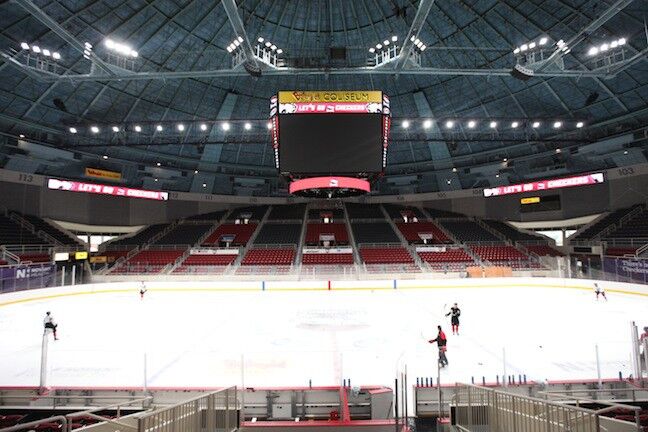Venue Sound, Part 2: Integrators Face a Complicated Audio Landscape
Story Highlights
The seemingly unending construction project that is sports-venue infrastructure has been a boon to the A/V systems that have turned it into an extension of viewers’ living rooms. Immersive full-range sound complements the stadiums’ and arenas’ massive HD videoboards. But sound seems to pose some surprising concerns.
Continuing a long narrative of audio contretemps that include weaponized sound systems that drown out opposing quarterback cadences, the Minnesota Vikings’ new U.S. Bank Stadium made the news this season for being just too darn loud, with its cacophony reportedly exceeding an ear-piercing 105 dB, coming in somewhere between the point at which hearing damage is possible and the threshold for human pain.
The Vikings’ plight underscores the fact that those who put those sound systems into sports venues have to a walk a fine line these days: satisfy management’s and the fans’ desire for sheer, brute-force volume and staying within the increasingly strict guidelines that publicity-shy and litigation-averse leagues are imposing.
A Change in Mission
“Twenty years ago, the public-address system was just that — a way to convey information: who’s at bat, what the ref is saying,” observes Pete O’Neil, director, engineering, Diversified Systems, an A/V integrator whose recent portfolio includes the Miami Dolphins’ Hard Rock Stadium and the Detroit Lions’ Ford Field. “Today, though, the PA system is part of a huge entertainment system that’s trying to give fans what they can’t get at home on television.”

Bojangles’ Coliseum, which hosts events ranging from \Les Misérables to the AHL’s Charlotte Checkers, received a new sound system comprising VUE Audiotechnik al-Class loudspeakers.
An example of how that mandate is propelling sound is in the new Meyer LEO sound system that Diversified installed at Ford Field and the arrayed Meyer LFC-1100 cardioid subwoofers that both add an afterburner effect to the signature “roar” as the team enters the field and keep more of that energy on the seating areas.
“Enhanced low-frequency energy helps something like that take on a new dimension, and the team and the stadium management understand that,” says O’Neil. “But what’s been harder to get across is that more noise without thinking about how that interacts with the [venue’s] acoustics can create an atmosphere that’s not pleasant. It’s been an uphill fight.”
He says the solution is to bring the issue of acoustics into the equation as early as possible, preferably in the architectural-design phase. Teams and ownership, he notes, are bringing him as the integrator into the planning discussions earlier. It’s a good sign, which he attributes to a greater awareness of the need to make these venues as accommodating as possible to a wide array of event uses, to increase rental income, to steer clear of outcomes like that at the US Open tennis tournament in Flushing, NY, in September, where a new retractable roof exacerbated longstanding noise problems.
“They used to lump us in with the electrical contractors,” says O’Neil. “Now they’re realizing that it’s a much more complicated issue. It’s not just the parts you’re using but also how you put them together.”
Better Tools
Addressing acoustical issues is especially difficult when existing sound systems are renovated, because the architecture is generally fixed at that point. Improvements in PA products, though, are helping direct and contain sound better. Steerable arrays and more-precise waveguides keep sound on seats and off reflective surfaces. That helps contain noise even as it improves speech intelligibility. Other performance parameters, such as gain before feedback, have also improved, thanks to better digital signal processing. And system designs themselves are more accurate, thanks to more-precise predictive modeling software that lets designers and integrators “see” where sound will go in the blueprint stage.
Overseas sound-reinforcement brands are also making some headway in the U.S., offering designers and integrators more choices and more-competitive pricing. Germany-based d&b audiotechnik, whose systems were used at this year’s European Games, has systems at the Thomas & Mack Center at UNLV and the Bojangles’ Coliseum in Charlotte, NC. Spain-based D.A.S. Audio, which has installed systems in Europe including the Broendby Hallen Arena in Copenhagen, now also has a system at the Gaylord Entertainment Center, home to the NHL Nashville Predators. France-based Nexo, distributed in the U.S. by Yamaha Commercial Audio Systems, has installations at the University of Toledo Glass Bowl Stadium, the Doyt L. Perry Stadium and the Stroh Center Arena on the Bowling Green State university campus, and Fifth Third Field, home of the Toledo Mud Hens.
Other new technologies have been making their way into sports fields. Paul Murdick, president of TSI Technologies Solutions, a division of TSI Global, whose sports portfolio comprises the Edward Jones Dome, points to the rapid uptake of networked audio in the wake of the high adoption rate of Audinate’s Dante networking platform. That, he says, has contributed to more-efficient systems designs and far less cabling, meaning that budgets can be diverted to other aspects of the sound system.
“We’d had promises of an improved CobraNet and then AVB, but they never delivered,” he explains. “Dante at least gives us a de facto standard that we can work with. It also allows us to combine more components from different manufacturers in a single system, which can improve the overall performance.”
Even so, Murdick says, the ultimate outcome of a venue sound system comes down to budget: what are stadiums and teams willing to spend for sound? That question has historically received less-than-satisfactory answers as far as A/V integrators are concerned. But, as the convergence of sports and live entertainment continues — and the latter has always placed a heavy emphasis on sonic quality — the answers will likely start to sound better and better.
